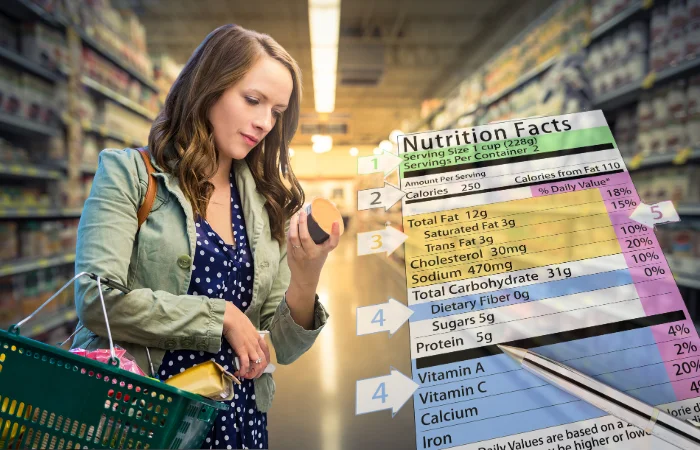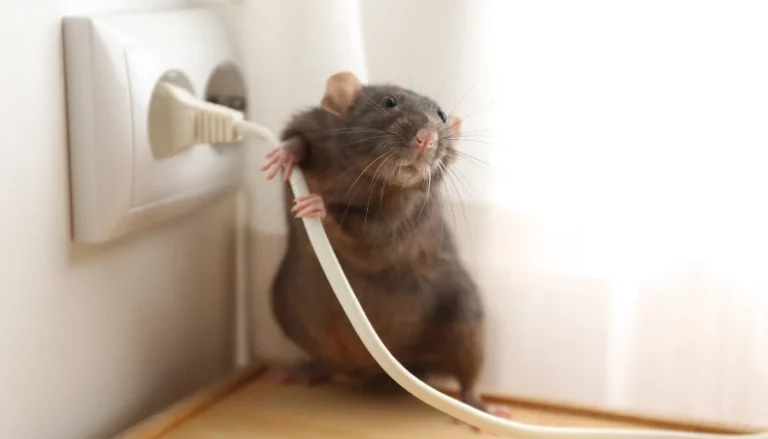Navigating the supermarket aisles can be a daunting task, especially when trying to avoid processed foods. To help you out, we’ve put together a very quick and efficient guide to help you become a savvy shopper by understanding and interpreting food labels effectively.
But first… we need to discuss tricky marketing when it comes to food and food labels.
In an era where most grocery store shelves are filled with processed foods, manufacturers often use clever marketing tactics to promote these products as healthy options.
Phrases like “contains real fruit” or “fortified with vitamins” are designed to catch the eye and give the impression of nutritional value. However, these claims can be misleading and may not tell the whole story about what’s in your food.
Unpacking Health Claims on Packaging
Food packaging is often the first place where consumers encounter marketing messages. Here are the most frequently used claims that you undoubtedly see each time to go to the grocery store:
- “Contains Real Fruit”: This phrase suggests the product is wholesome and nutritious. However, the actual fruit content can be minimal, and the product may be laden with added sugars or fruit concentrates that are far removed from the nutritional profile of whole fruit. Keep in mind that to “contain real fruit” it, quite literally, just contain any real fruit or fruit byproduct; 1% of fruit still “contains real fruit”.
- “Fortified with Vitamins”: While fortification can help replace nutrients lost during processing or provide a nutritional boost, it doesn’t automatically make a food healthy. For instance, a breakfast cereal might be fortified with vitamins but could also be high in sugar and low in fiber. Just remember that fortification doesn’t equate to nutritious and healthy!
- “Natural” or “All-Natural”: These terms aren’t strictly regulated by the FDA, meaning they can be used liberally, and often are. A product labeled as “natural” may still contain high levels of processed ingredients like high-fructose corn syrup or even BVO.
The Ingredient List: Your Nutritional Compass
To truly understand what you’re eating, you must bypass the flashy health claims and go straight to the ingredient list. Here’s what you need to know:
- Order of Ingredients: Ingredients are listed by volume, from highest to lowest. If sugar or a processed ingredient is near the top, that’s a red flag.
- Length of the List: A long list often indicates a highly processed product. Whole foods and minimally processed foods typically have shorter lists with recognizable ingredients.
- Unfamiliar Ingredients: Many additives and preservatives have complex names that can be confusing. A rule of thumb is if you can’t pronounce it or don’t know what it is without looking it up, it’s likely heavily processed.
Just because something contains fruit, doesn’t make it healthy for you! Packaged cookies of any kind are far from nutritional. Some people like to believe that fat-free is the best option, when in fact, it’s really not. The fat is replaced with sugar and just so much of it! Nine grams of the 13g of sugar are added sugars.
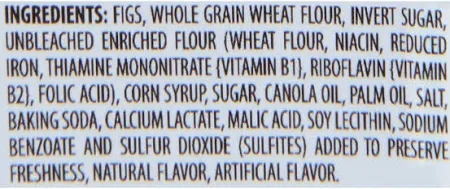
Look at that ingredients list! Sugar is the third, eighth and ninth ingredients! Not to mention all the oils (and what palm oil does on the wider scope).
Just eat a fig on its own! They’re naturally sweet and contain potassium, calcium, iron, and vitamins.
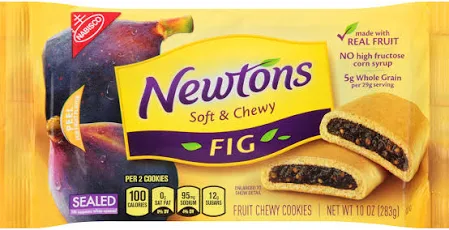
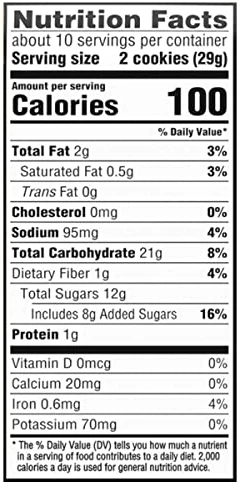
Understanding Nutritional Panels
Nutritional panels provide a snapshot of the food’s caloric and nutrient content. Here’s what to look for:
- Fiber Content: High fiber content is a good indicator of a less processed product. Processed grains often have the fiber-rich outer layers removed.
- Added Sugars: The FDA now requires added sugars to be listed on nutritional labels, making it easier to see how much sugar has been included beyond what’s naturally found in the ingredients.
The Role of Data in Unveiling Marketing Tactics
Research studies have shown that front-of-package claims can significantly influence consumer perceptions.
For example, a study published in the Journal of Marketing Research indicated that products with health-related claims were perceived as healthier than those without, even when their nutrition labels showed no significant differences.
Simply put, when a company designs a food label to appear healthy, people assume it is even when it’s not.
Moreover, the FDA’s Food Labeling Guide provides data-backed guidelines for manufacturers on what they can and cannot claim on their packaging, offering a resource for consumers to understand the regulations behind these claims.
This brings us to our quick guide on spotting processed foods. Now, of course, the general rule when it comes to nutrition labels is simple, if you can’t pronounce it and/or don’t recognize it, that means it’s heavily processed.
There are a few tell-tale ‘regulars’ to be on the lookout for, though:
-
- “Hydrogenated” or “Partially Hydrogenated Oils”: These terms indicate the presence of trans fats, which are created by adding hydrogen to vegetable oil, a process that increases shelf life and flavor stability. Trans fats are associated with an increased risk of heart disease.
- High-Fructose Corn Syrup (HFCS): A common sweetener made from corn starch, HFCS is often found in sodas, sweets, and baked goods. Its high level of processing and association with various health issues makes it a key marker of heavily processed foods.
- Monosodium Glutamate (MSG): Often used to enhance flavor, MSG is a flavor enhancer that can be found in savory processed foods such as snacks, frozen meals, and seasonings.
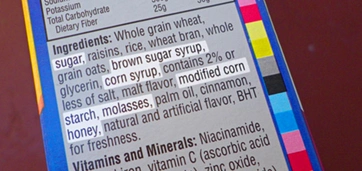
Sugar Has Many Names
Sugar isn't always listed as ‘sugar’ in the ingredients. Names such as corn syrup, glucose, sucrose, maltose, dextrose, brown rice syrup, honey, syrup and hydrolyzed starch are examples of types of sugar. The higher up on the ingredient list, the higher the amounts of added sugar is in the product. The label at the left shows six added sugars in this product!
Moving past the regular culprits of processed ingredients, you also need to be aware of the calories, fats, sugars, and sodium content. Interpreting these figures is straight-forward:
- Sugars: Watch out for sugars listed under different names, such as sucrose, maltose, dextrose, and syrups. Remember, sugars occur naturally in some foods like dairy (lactose) and fruit (fructose), but it’s the added sugars in processed foods that you need to monitor.
- Fats: Check for saturated and trans fats, which should be limited in a healthy diet. Keep in mind that “0g trans fat” labels can be misleading; if “partially hydrogenated oil” is listed in the ingredients, the product still contains trans-fat.
- Sodium: High sodium levels are a hallmark of processed foods. The daily recommended maximum for most adults is 2,300 milligrams, but many processed foods can contain half of that, or more, in a single serving.
The Basic Math of Nutrient Density vs. Calorie Density
Beyond the presence of specific ingredients, understanding the relationship between nutrient density (the amount of nutrients relative to calories) and calorie density (the number of calories in a given weight or volume of food) is key.
Processed foods often have high calorie density with low nutrient density, meaning they pack a lot of calories without beneficial nutrients.
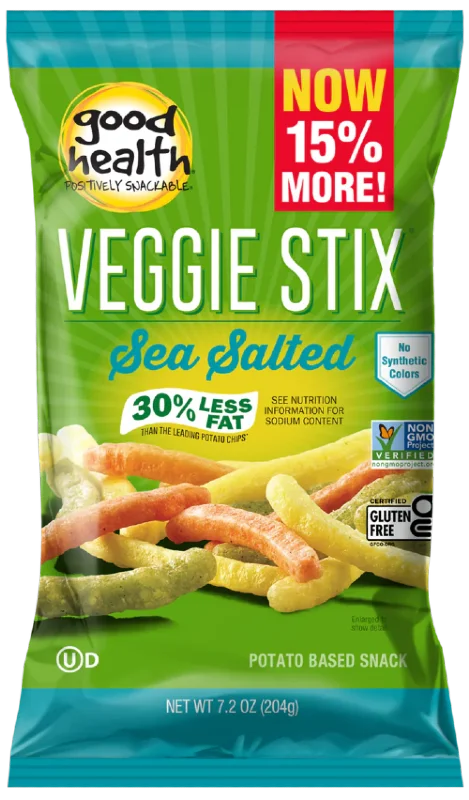
Chips made from vegetables sounds super healthy, right? The name and the packaging are certainly designed to make us believe they’re good for us. When we think vegetables, we expect fiber, vitamins and minerals and all kinds of good stuff. You won’t find any of that! What you will find is a ton of sodium and a lot of starch and oil.

Top 10 Golden Rules for Deciphering Food Labels
Reading a food label is a critical skill for maintaining a healthy diet. Understanding what’s behind the packaging can help you make better choices. Here are ten rules to guide you through this process.
Rule 1: Food as Fuel
Recognize that food is the body’s fuel. Everything you eat powers your activities and bodily functions, just like fuel powers various machines.
Rule 2: Calories Count
Calories measure the energy food provides. An avocado might contain more calories than a soda, but it’s packed with nutrients that the body needs for energy, making it a superior choice.
Rule 3: Serving Size Clarity
Always check the serving size first. It’s easy to assume that the calorie count refers to the whole package. For instance, a single serving of cereal might be 3/4 cup, which could be far less than what typically goes into a bowl.
Rule 4: Multiplying Calories
If you eat more than the serving size, you need to multiply the calories accordingly. Eating two servings? Double the number on the label. It’s simple math that can keep your diet in check.
Rule 5: Understanding Macronutrients
There are three macronutrients: fats, carbohydrates, and proteins. For example, a label might show a protein bar with 20 grams of protein, which is beneficial, but also look for the fat and carbohydrate content to ensure balance.
Rule 6: The Truth About Fats
Fats are calorie dense. A tablespoon of olive oil has about 120 calories. Opt for healthy fats, but be mindful of portion sizes.

Avoid Energy, Protein, Granola Bars
They're processed foods, which should automatically make you question the claims of health and nutrition often slapped across their packaging! When you eat fake healthy food like a store-bought energy bar, the only things you are consuming are super sweet and processed brown rice syrup, cane syrup, cane sugar, and a fair amount of carbs.
Rule 7: Carbohydrates and Sugars
Carbohydrates provide energy, but not all carbs are equal. Look for whole grains over refined ones, and be wary of added sugars. For instance, a granola bar might have oats (good) but be coated in honey (sugar overload).
Rule 8: Protein in Moderation
While protein is essential for building and repairing tissues, too much of it can lead to excess calorie intake if you’re not burning it off, resulting in weight gain. A chicken breast might be a great source of protein, but two might be more than you need.
Rule 9: Ingredients You Can Pronounce
If the list of ingredients reads like a chemical experiment, it’s probably highly processed. Look for whole food ingredients you recognize and can pronounce, like “roasted almonds” or “dried cranberries.”
Rule 10: The Shorter the List, the Better
A long list of ingredients often indicates a highly processed food. For example, compare the label of a whole-grain loaf of bread with a few simple ingredients to a commercial loaf with a paragraph of additives.
Remember, the best foods for your health typically come with minimal packaging and processing. When in doubt, choose foods that remain as close to their natural state as possible, and always consider the balance and total intake of your macronutrients.
By using these label-reading strategies, you can better discern which foods are heavily processed and make choices that align with a nutrient-rich diet. The goal isn’t perfection but informed decision-making that contributes to your overall health and well-being.
Now, let’s combine everything we’ve learned and examine a food label together.
Putting It Together: Breaking Down A Food Label
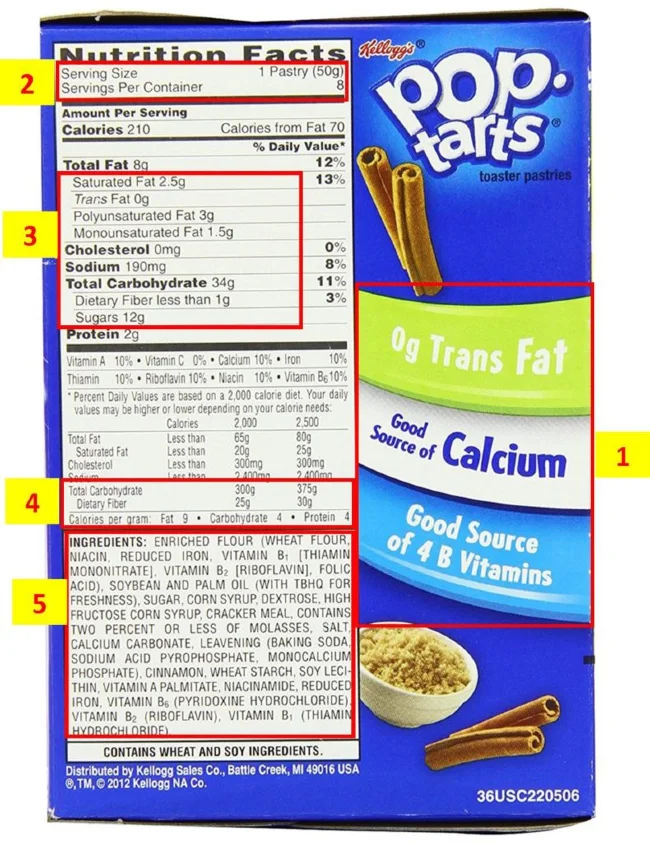
Never believe the health claims on the front!
This Pop Tarts package advertises that it contains calcium and B vitamins. The company added those to make their unhealthy product easier to market to you.
The serving size is 1 pastry, with each individual package containing 2 Pop Tarts. Do you know anyone who eats only one? So, you’ll need to multiply each category on the label by two. Now, Kellogg’s could have done this for us, but then they’d have to list the real total calories and nutrition on the label and that’s horrifying!
Eating both will give you 420 calories, 16g of fat, 5g of saturated fat, 380g of sodium, and 24g of sugar.
Pay close attention to the three S’s on the nutrition label: saturated fat, sodium, and sugar.
- Saturated Fat: The FDA recommends 20g or less of saturated fat per day, so avoid foods with more than three or four grams per serving. Most saturated fat in our diets comes from processed foods.
- Sugar: Sugar is tricky because labels don't indicate how much sugar is actually added to a food, versus how much occurs naturally from ingredients like fruit and milk. Added sugar, which has lots of names, including any type of syrup and any chemical name ending with “-ose”, should be limited to 6-9 tsp, or 24-36g, a day—less than a 12 oz can of Coke. There are 24g of sugar in these pop tarts, which is as much sugar as a child should eat in an entire day!
- Sodium: A handy trick that requires some basic math to help determine if a food has a healthy amount of sodium is to compare the milligrams of sodium to the number of calories in the food. If the number of milligrams of sodium is within 100 of the number of calories, then it’s a healthy amount of sodium. In the case of the pop tarts, the 190 mg of sodium is right in line with the 210 calories, so this food is not overly high in sodium. It's far from healthy for so many other reasons, but the sodium isn't out of control.
And finally, let’s glance over the ingredients list…
We know that ingredients are listed in order of quantity, so the most prevalent ingredients are listed first. So if enriched wheat flour (the stuff in white bread, and Pop Tarts) and sugar are high up on the list, the food is low in nutritional value.
Look out for sneaky unhealthy ingredients that often hide on the label. The words “hydrogenated oils” tell us that the food has some quantity of trans-fat, and they are best avoided altogether. And yes, manufacturers can list 0g trans fat even when the item contains trans fat.
Remember to be on the lookout for the alternative words for sugar; any type of syrup and any word ending in “-ose.”







